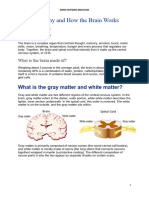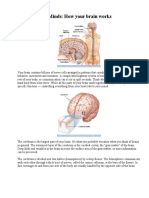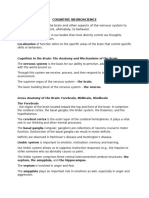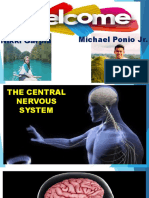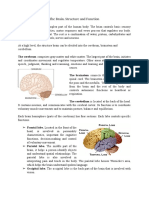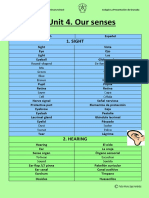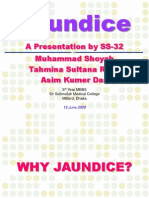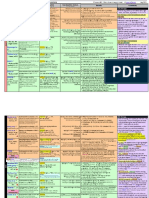0 ratings0% found this document useful (0 votes)
7 viewsBrain and Structute
Brain and Structute
Uploaded by
dhatreyi.g.gubbalaCopyright:
© All Rights Reserved
Available Formats
Download as PPTX, PDF, TXT or read online from Scribd
Brain and Structute
Brain and Structute
Uploaded by
dhatreyi.g.gubbala0 ratings0% found this document useful (0 votes)
7 views10 pagesOriginal Title
Brain and Structute(1)
Copyright
© © All Rights Reserved
Available Formats
PPTX, PDF, TXT or read online from Scribd
Share this document
Did you find this document useful?
Is this content inappropriate?
Copyright:
© All Rights Reserved
Available Formats
Download as PPTX, PDF, TXT or read online from Scribd
Download as pptx, pdf, or txt
0 ratings0% found this document useful (0 votes)
7 views10 pagesBrain and Structute
Brain and Structute
Uploaded by
dhatreyi.g.gubbalaCopyright:
© All Rights Reserved
Available Formats
Download as PPTX, PDF, TXT or read online from Scribd
Download as pptx, pdf, or txt
You are on page 1of 10
BRAIN AND STRUCTURE
The brain is a complex organ that controls
thought, memory, emotion, touch, motor
skills, vision, breathing, temperature, hunger
and every process that regulates our body.
Together, the brain and spinal cord that
extends from it make up the central nervous
system, or CNS.
How does the brain work?
The brain sends and receives chemical and electrical signals
throughout the body. Different signals control different
processes, and your brain interprets each. Some make you
feel tired, for example, while others make you feel pain.
Some messages are kept within the brain, while others are
relayed through the spine and across the body’s vast network
of nerves to distant extremities. To do this, the central
nervous system relies on billions of neurons (nerve cells).
Main Parts of the Brain and Their Functions
At a high level, the brain can be divided into the cerebrum,
brainstem and cerebellum.
Cerebrum
The cerebrum (front of brain) comprises gray matter (the cerebral cortex) and white
matter at its center. The largest part of the brain, the cerebrum initiates and
coordinates movement and regulates temperature. Other areas of the cerebrum
enable speech, judgment, thinking and reasoning, problem-solving, emotions and
learning. Other functions relate to vision, hearing, touch and other senses.
Cerebral Cortex
Cortex is Latin for “bark,” and describes the outer gray matter covering of the
cerebrum. The cortex has a large surface area due to its folds, and comprises about
half of the brain’s weight.
The cerebral cortex is divided into two halves, or hemispheres. It is covered with
ridges (gyri) and folds (sulci). The two halves join at a large, deep sulcus (the
interhemispheric fissure, AKA the medial longitudinal fissure) that runs from the front
of the head to the back. The right hemisphere controls the left side of the body, and
the left half controls the right side of the body. The two halves communicate with one
another through a large, C-shaped structure of white matter and nerve pathways
called the corpus callosum. The corpus callosum is in the center of the cerebrum.
Brainstem
The brainstem (middle of brain) connects the cerebrum with the spinal cord. The brainstem includes the midbrain,
the pons and the medulla.
Midbrain. The midbrain (or mesencephalon) is a very complex structure with a range of different neuron clusters
(nuclei and colliculi), neural pathways and other structures. These features facilitate various functions, from hearing
and movement to calculating responses and environmental changes. The midbrain also contains the substantia nigra,
an area affected by Parkinson’s disease that is rich in dopamine neurons and part of the basal ganglia, which enables
movement and coordination.
Pons. The pons is the origin for four of the 12 cranial nerves, which enable a range of activities such as tear
production, chewing, blinking, focusing vision, balance, hearing and facial expression. Named for the Latin word for
“bridge,” the pons is the connection between the midbrain and the medulla.
Medulla. At the bottom of the brainstem, the medulla is where the brain meets the spinal cord. The medulla is
essential to survival. Functions of the medulla regulate many bodily activities, including heart rhythm, breathing,
blood flow, and oxygen and carbon dioxide levels. The medulla produces reflexive activities such as sneezing,
vomiting, coughing and swallowing.
The spinal cord extends from the bottom of the medulla and through a large opening in the bottom of the skull.
Supported by the vertebrae, the spinal cord carries messages to and from the brain and the rest of the body.
Cerebellum
The cerebellum (“little brain”) is a fist-sized portion of the brain located at the back of the head, below the temporal
and occipital lobes and above the brainstem. Like the cerebral cortex, it has two hemispheres. The outer portion
contains neurons, and the inner area communicates with the cerebral cortex. Its function is to coordinate voluntary
muscle movements and to maintain posture, balance and equilibrium. New studies are exploring the cerebellum’s
roles in thought, emotions and social behavior, as well as its possible involvement in addiction, autism and
schizophrenia.
Frontal lobe. The largest lobe of the brain, located in the front of the head,
the frontal lobe is involved in personality characteristics, decision-making
and movement. Recognition of smell usually involves parts of the frontal
lobe. The frontal lobe contains Broca’s area, which is associated with speech
ability.
Parietal lobe. The middle part of the brain, the parietal lobe helps a person
identify objects and understand spatial relationships (where one’s body is
compared with objects around the person). The parietal lobe is also
involved in interpreting pain and touch in the body. The parietal lobe houses
Wernicke’s area, which helps the brain understand spoken language.
Occipital lobe. The occipital lobe is the back part of the brain that is
involved with vision.
Temporal lobe. The sides of the brain, temporal lobes are involved in short-
term memory, speech, musical rhythm and some degree of smell
recognition.
Deeper Structures Within the Brain
Pituitary Gland
Sometimes called the “master gland,” the pituitary gland is a pea-sized structure found deep in the brain
behind the bridge of the nose. The pituitary gland governs the function of other glands in the body, regulating
the flow of hormones from the thyroid, adrenals, ovaries and testicles. It receives chemical signals from the
hypothalamus through its stalk and blood supply.
Hypothalamus
The hypothalamus is located above the pituitary gland and sends it chemical messages that control its
function. It regulates body temperature, synchronizes sleep patterns, controls hunger and thirst and also
plays a role in some aspects of memory and emotion.
Amygdala
Small, almond-shaped structures, an amygdala is located under each half (hemisphere) of the brain. Included
in the limbic system, the amygdalae regulate emotion and memory and are associated with the brain’s
reward system, stress, and the “fight or flight” response when someone perceives a threat.
Hippocampus
A curved seahorse-shaped organ on the underside of each temporal lobe, the hippocampus is part of a larger
structure called the hippocampal formation. It supports memory, learning, navigation and perception of
space. It receives information from the cerebral cortex and may play a role in Alzheimer’s disease.
Pineal Gland
The pineal gland is located deep in the brain and attached by a stalk to the top of the third ventricle. The
pineal gland responds to light and dark and secretes melatonin, which regulates circadian rhythms and the
sleep-wake cycle.
You might also like
- Humans Body Systems QuestionsDocument2 pagesHumans Body Systems QuestionsMichael Plexousakis100% (1)
- EKG Interpretation Algorithm (Including Mean Electrical Axis Changes)Document4 pagesEKG Interpretation Algorithm (Including Mean Electrical Axis Changes)Joyce TingNo ratings yet
- Human BrainDocument11 pagesHuman Brainmuskaan.kukrejaNo ratings yet
- Brain Anatomy and How The Brain WorksDocument10 pagesBrain Anatomy and How The Brain WorksSANJEEV SADASIVANNo ratings yet
- Ms - Angeline M.SC (N) Previous Year Psychiatric Nursing Choithram College of NursingDocument79 pagesMs - Angeline M.SC (N) Previous Year Psychiatric Nursing Choithram College of NursingPankaj TirkeyNo ratings yet
- How Your Brain WorksDocument12 pagesHow Your Brain WorksPallavi BhartiNo ratings yet
- "Cognitive Psychology": Sir Faisal Mumtaz Zeeshan Akhtar Bsap 3 005 20 Jan, 2021Document9 pages"Cognitive Psychology": Sir Faisal Mumtaz Zeeshan Akhtar Bsap 3 005 20 Jan, 2021Zeeshan AkhtarNo ratings yet
- Brain Anatomy and How The Brain WorksDocument1 pageBrain Anatomy and How The Brain Worksdudong borjaNo ratings yet
- Nervous SystemDocument34 pagesNervous SystemumeazabashaNo ratings yet
- Anatomy of StrokeDocument4 pagesAnatomy of StrokeMarvin Manuel RamosNo ratings yet
- Cognitive Development ModuleDocument20 pagesCognitive Development ModuleMaria Mendoza AlejandriaNo ratings yet
- HNP - Predisposing FDocument42 pagesHNP - Predisposing FLady Jean Milan ColataNo ratings yet
- ZARISH JAVED053, COGNITIVE, BSCP4ADocument8 pagesZARISH JAVED053, COGNITIVE, BSCP4Ajaverianoor030No ratings yet
- The Central Nervous SystemDocument24 pagesThe Central Nervous SystemBlanche Mascarinas LaborteNo ratings yet
- Structures of BrainDocument29 pagesStructures of Brainmishal.sarosh75No ratings yet
- c5730d07 Week 3 ss3Document4 pagesc5730d07 Week 3 ss3isabellaamelia54321No ratings yet
- OUR BODY Chapter - I (Science Class IV)Document4 pagesOUR BODY Chapter - I (Science Class IV)doultaniskNo ratings yet
- Dia GridDocument7 pagesDia GridMark Ross CanaoayNo ratings yet
- Brain Structures and Their Functions 1 PDFDocument3 pagesBrain Structures and Their Functions 1 PDFAndrea RamirezNo ratings yet
- Human BrainDocument13 pagesHuman BrainAaniya AsadNo ratings yet
- Chapter 4 Brain AnatomyDocument18 pagesChapter 4 Brain AnatomyJohn Peter CarbonelNo ratings yet
- Structure of BrainDocument24 pagesStructure of Brainhajiwaheed0604No ratings yet
- Anatomia e Sistema NerosoDocument8 pagesAnatomia e Sistema NerosoChloe BujuoirNo ratings yet
- Brain System: Parts and FunctionsDocument9 pagesBrain System: Parts and FunctionsChristhoper John Dela CruzNo ratings yet
- General Brain Structure N FunctionDocument6 pagesGeneral Brain Structure N Function'Niq Hdyn100% (1)
- Introduction To BrainDocument3 pagesIntroduction To BrainrgdevikaNo ratings yet
- COGNITIVE-NEUROSCIENCEDocument4 pagesCOGNITIVE-NEUROSCIENCEAbigail Joy AnchetaNo ratings yet
- Human Growth And DevelopmentDocument74 pagesHuman Growth And Developmentanjanasaju1213No ratings yet
- Anatomy of Human BrainDocument2 pagesAnatomy of Human BrainIan Rhadel RaganasNo ratings yet
- Preparation in Psychology: Bicol University College of Engineering East Campus LegazpiDocument8 pagesPreparation in Psychology: Bicol University College of Engineering East Campus LegazpiKielNo ratings yet
- The BrainDocument28 pagesThe BrainAnania EmmanuelNo ratings yet
- Anatomy and Physiology of The BrainDocument2 pagesAnatomy and Physiology of The BrainkazelleNo ratings yet
- Nervous SystemDocument8 pagesNervous Systemkitkat22phNo ratings yet
- Anatomy and FunctionDocument3 pagesAnatomy and FunctionKalebNo ratings yet
- BrainDocument35 pagesBrainRonaleen mislang100% (1)
- Neuro Ppt. Lec. 1Document49 pagesNeuro Ppt. Lec. 1Jay successNo ratings yet
- Brain InfoDocument3 pagesBrain InfoRona May EsperanzateNo ratings yet
- What Is Neuron?Document8 pagesWhat Is Neuron?Shaekh Maruf Skder 1912892630No ratings yet
- Anatomy and Physiology of The BrainDocument22 pagesAnatomy and Physiology of The BrainJonathan Delos ReyesNo ratings yet
- โท the BrainDocument39 pagesโท the BrainFadil Wanna-mart100% (1)
- Human BrainDocument12 pagesHuman BrainJashwanthNo ratings yet
- Parts of The Brain and FunctionsDocument3 pagesParts of The Brain and FunctionsLee Ayn PoncardasNo ratings yet
- Brain Anatomy and How The Brain Works-Ahsan IqbalDocument18 pagesBrain Anatomy and How The Brain Works-Ahsan Iqbalaq331560No ratings yet
- Brain Structure and FunctionDocument5 pagesBrain Structure and Functionmademoiselle in transitNo ratings yet
- Cognitive Nueroscience - NotesDocument8 pagesCognitive Nueroscience - NotesEirrah AcenasNo ratings yet
- Brain Basics - Know Your Brain - National Institute of Neurological Disorders and StrokeDocument4 pagesBrain Basics - Know Your Brain - National Institute of Neurological Disorders and Strokesurajit halderNo ratings yet
- BSE 1105 NEURO PSYCHOLOGY Copy 5Document22 pagesBSE 1105 NEURO PSYCHOLOGY Copy 5salvineobonyo7777No ratings yet
- Anatomy and Physiology of The BrainDocument6 pagesAnatomy and Physiology of The Brainangel16_88No ratings yet
- Anatomy of The Brain and FunctionsDocument4 pagesAnatomy of The Brain and FunctionsGopinadh GanjiNo ratings yet
- The Frontal Lobe Is The MostDocument6 pagesThe Frontal Lobe Is The MostJingky MarzanPurisima Lumauig SallicopNo ratings yet
- Health Psychology - The BrainDocument3 pagesHealth Psychology - The BrainSaerah ParkNo ratings yet
- The BrainDocument2 pagesThe BrainFernanda TéllezNo ratings yet
- PERDEV Group 4 Power of MindDocument28 pagesPERDEV Group 4 Power of MindAhron SanchezNo ratings yet
- Anatomy and PhysiologyDocument11 pagesAnatomy and PhysiologyremegelbristolNo ratings yet
- Anatomy and Physiology of Central Nervous SystemDocument54 pagesAnatomy and Physiology of Central Nervous Systemsarahnakato439No ratings yet
- Discuss Action Potential of The Axon and Nerve ImpulseDocument3 pagesDiscuss Action Potential of The Axon and Nerve ImpulsePink PastaNo ratings yet
- Master Your Mind: Neuroscience Secrets to Unlocking Your PotentialFrom EverandMaster Your Mind: Neuroscience Secrets to Unlocking Your PotentialNo ratings yet
- Brain Health - How to Have a Healthy Memory and a Healthy BrainFrom EverandBrain Health - How to Have a Healthy Memory and a Healthy BrainNo ratings yet
- Super Brain: Strategies to Upgrade Your Brain, Unlock Your Potential, Perform at Your Peak, and Achieve AnythingFrom EverandSuper Brain: Strategies to Upgrade Your Brain, Unlock Your Potential, Perform at Your Peak, and Achieve AnythingNo ratings yet
- Horse Anatomy (VetBooks - Ir)Document36 pagesHorse Anatomy (VetBooks - Ir)Ana RosaNo ratings yet
- Human Digestive SystemDocument11 pagesHuman Digestive SystemSyeda NafeezaNo ratings yet
- Interpretation of Liver Function TestsDocument14 pagesInterpretation of Liver Function TestsNirav SharmaNo ratings yet
- Cardiovascular SystemDocument26 pagesCardiovascular SystemdumbledoreaaaaNo ratings yet
- Unit 4. Our Senses: 1. SightDocument3 pagesUnit 4. Our Senses: 1. SightDavid EcheverriaNo ratings yet
- A Case Study Of: Hypertension Emergency, Hypertensive Cardiovascular DiseaseDocument23 pagesA Case Study Of: Hypertension Emergency, Hypertensive Cardiovascular DiseaseKristine AlejandroNo ratings yet
- Heart Failure With Reduced Ejection Fraction (Systolic Heart Failure)Document1 pageHeart Failure With Reduced Ejection Fraction (Systolic Heart Failure)Cecil-An DalanonNo ratings yet
- Human Digestion PresentationDocument35 pagesHuman Digestion PresentationYamyang Galay-BañoNo ratings yet
- NCM 107 - Male and Female Reproductive SystemDocument9 pagesNCM 107 - Male and Female Reproductive SystemKrizamay Ongat AggerNo ratings yet
- Approach To Pediatric Neurology - BasicDocument16 pagesApproach To Pediatric Neurology - BasicAseel AyNo ratings yet
- Extensive Video-Game Experience Alters Cortical Networks For Complex Visuomotor TransformationsDocument13 pagesExtensive Video-Game Experience Alters Cortical Networks For Complex Visuomotor TransformationsDanny WijayaNo ratings yet
- Cosme García C. Bilingual School Danlí, El Paraíso: 3 Grade SCIENCE Review - I Academic Term Lesson 1: Body PartsDocument1 pageCosme García C. Bilingual School Danlí, El Paraíso: 3 Grade SCIENCE Review - I Academic Term Lesson 1: Body PartsNelson Salgado100% (2)
- Crash Course Anatomy and Physiology EndoccrineDocument9 pagesCrash Course Anatomy and Physiology EndoccrineReem SleemNo ratings yet
- Transport of NutrientsDocument13 pagesTransport of NutrientsmahbieNo ratings yet
- New MCQS AnatomyDocument50 pagesNew MCQS AnatomyEntertainment StatusNo ratings yet
- Endocrine Ed WorksheetDocument2 pagesEndocrine Ed WorksheetCathleen Shane CarcabusoNo ratings yet
- 8ad Science Yr 8Document16 pages8ad Science Yr 8maryamNo ratings yet
- Portal Hypertension Radiology Reference Article PDFDocument1 pagePortal Hypertension Radiology Reference Article PDFSandy KamatNo ratings yet
- Anatomy of CNSDocument32 pagesAnatomy of CNSLeonita AguillonNo ratings yet
- Basics of Biomedical InstrumentationDocument45 pagesBasics of Biomedical Instrumentationaarthir88100% (1)
- The Digestive System Powerpoint 1227698045024899 8Document44 pagesThe Digestive System Powerpoint 1227698045024899 8SunnyReduNo ratings yet
- Jaundice: From Superstition To ScienceDocument93 pagesJaundice: From Superstition To ScienceDr Muhammad ShoyabNo ratings yet
- Hepatoprotection by L-Ornithine L-Aspartate in NonDocument6 pagesHepatoprotection by L-Ornithine L-Aspartate in NonNabeel Ahmed KhanNo ratings yet
- Rat Digestive SystemDocument5 pagesRat Digestive SystemAnkit NariyaNo ratings yet
- Embryology of Urogenital SystemDocument42 pagesEmbryology of Urogenital SystemAngetile Kasanga100% (1)
- Structure and Function of SkinDocument4 pagesStructure and Function of SkinSarah AndersonNo ratings yet
- SkinDocument8 pagesSkinkuu faalNo ratings yet
- CHT Anemia Key TrialsDocument3 pagesCHT Anemia Key Trialsmehnoor kaurNo ratings yet



